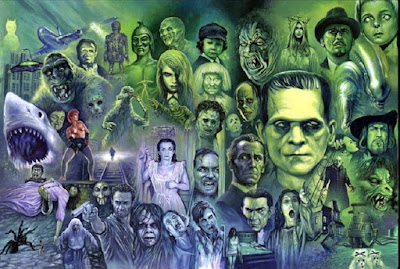Copyright 2020 by Gary L. Pullman
Judging by its trailer,
the monster of The Sand (2015)
is integral to the movie's setting:
A red plastic cup lying, half-buried in the sand,
litters an otherwise pristine beach. Waves roll toward the shore,
carrying, upon the surface of their waters, green slime suggestive of
pulverized vegetation or algae, implying that nature, too, is a
litterbug of sorts. A mechanical device, embedded in the sand
elsewhere on the beach, among dunes and reeds, is a sign of the
presence of human technology amid natural landscape features.
Night. Teenage boys in loud shirts cavort on the beach
with teenage girls in bikinis and other abbreviated attire. A boy
tosses beer from a red plastic cup toward squealing, grinning girls.
While performing a handstand on the sand, Marsha drinks beer,
upside-down, from the spigot of an upright keg. Another girl quaffs
her beverage from a red plastic cup. A boy does flips.
Vance warns, “Don't use Facebook or MySpace. Nothing
leaves this beach.” The party continues, in full swing.
The next morning, Kaylee looks over the beach from the
lifeguard tower where she's spent the night. The crowd is gone. Only
a few red plastic cups and the teens' sleeping bags and towels
remain.
Text appears, informing viewers that “66% of marine
species are still undiscovered today.”
A
seagull beats its wings, as it struggles to free its feet from the
sand. Kaylee, looking on, declares, “He's heavy.” She asks the
bird, “Are you stuck?” and is startled to see the bird sink (or
being pulled) into the sand until it disappears. “Oh, my God!”
she cries, backing up.
Text: “Until now.”
Holding her hand above the sand, Kaylee, with Mitch, who
also slept on the lifeguard tower, kneeling beside her, watches water
“rain” from her palm.
Kaylee runs across the platform, warning Marsha, “Don't
touch it!” Marsha's foot presses into the sand. A hand clutches the
girl's wrist, pulling upward.
The screen flickers as Kaylee's boyfriend Jonah and a
girl named Chandra, in the front seat, and Vance and his girlfriend
Ronnie, in the back seat, sit in a convertible parked on the beach
and look out toward the sea.
Mitch asks Kaylee, “So do you want to tell me what
just happened?”
“You saw,” Kaylee tells Mitch.
Gilbert frowns as he looks at something unseen by the
viewer.
Jonah tries to start his car, as Chandra yells, “Start
the car!”
“The car won't start,” he says. The teens are trapped in the convertible.
"We're all going to die,” Mitch predicts.
This is crazy,” Gilbert declares.
Mitch tosses a life preserver.
Mitch, his feet wrapped in towels, runs across the sand.
A police officer approaches a girl lying on on a picnic
table on the beach.
Chandra balances on an inflated raft as she walks across
the sand.
Jonah lies prone on the beach, suffering and unable to
move.
Vance leaps from the stranded convertible.
The police officer sprays Mace on the sand.
Energy crackles around the fingers and arm of a fallen
figure—the patrolman?—who lies on the beach.
Kaylee leaps from the lifeguard's tower, onto the sand.
Text: “like a monster.”
Kaylee waves her and shakes her head, saying, “I don't
believe in monsters.”
Jonah jumps back into the convertible.
Vance falls onto the beach.
A boy is pulled into the beach as he struggles,
clutching the bench of a picnic table.
Kaylee screams.
Night. A blonde in a red bikini backs up, screaming, as
she stares, horrified, at a gigantic tendril of light sweeping across
the sky. A car, the driver's door open, is parked beside her. The
tendril whips down. She ducks, and the tendril slams the car door
shut.
Against a black background, the film's title appear in
large red, centered letters:
The
Sand
An
Anything Horror review
of the movie posted on Horrorpedia
is mixed. The film jumps the shark, so to speak, when the monster is
introduced: director Isaac Gabareff apparently couldn't leave well
enough alone. He had to “give us the Big Monster,” and one which
he doesn't seem to have been able to afford, at that: “the money
spent on attempting this wouldn’t pay for a Pizza Hut meal,”
which, unfortunately, makes it look “cartoonish.”
There
are other problems with the special effects, too, reviewer Phil
Wheat, of Nerdy,
complains: “especially during a couple of the bigger, and gorier,
death scenes.” However, there's a silver lining: “it’s [a]
testament toThe Sand‘s
production that the low-budget nature of the effects don’t detract
too much from the overall experience.”
Another
reviewer has trouble with the plot, Luke Owen of Flickering
Myth finding
it “full of padding, a hammered[-]in love triangle and rather
unfunny jokes.”
For
his part, reviewer Christopher Stewart of UK
Horror Scene finds
the characters flat, the final girl somehow awkward, and the romance
cringe-worthy. Stewart disagrees in part with the Anything
Horror reviewer
concerning the monster's credibility, seeing “the monster effects”
as “decent” overall, although, he argues, “they don't seem
entirely integrated into the scene and come off a little cheap
looking.”
This
movie
itself shows how the monster in a story can (and, in the opinion of
Chillers and Thrillers,
should) be an integral part of the setting. It shouldn't
be merely an afterthought tacked onto the environment, but should arise from the story's setting as
naturally and believably as a shark rises from the depths of the
ocean, as a bear bounds across the floor of a forest, or as an eagle
swoops down from the sky.
It
seems that the octopus-thing or the squid-thing, or whatever kind of
thing the “undiscovered marine species” specimen-thing is (actually, it
turns out to be a giant electric jellyfish), is clearly integral to
the setting; it comes from the sea, onto the beach, to attack the
teens during spring break. All the pieces fit; there are not only
unity and coherence, but also integration and relevance. Of course,
whether the effects
are “integrated into the scene” as seamlessly and naturally as
the could and should be is another question.
Moreover,
the movie's posters also indicate that the monster is, indeed,
integral to the setting.
One
poster shows Kaylee running across the beach, leaning well forward.
There's a full moon in the dark sky, but the sand is dark and looks
more like both mud and water than sand as such. Indeed, at first
glance, it appears that Kaylee is running upon the surface of the
ocean, especially since the illuminated tentacle of the monster rises
from the sand beside her. Beneath the title, in solid, block red
letters is the caption, “This beach is killer.”
Another
poster shows a blonde wearing a bikini top resembling seashells; she
is buried in the beach up to her waist. Beneath the sand, two of the
monster's illuminated tentacles stretch toward her, even as a third
seems to attempt to surround her. On her knees, Kaylee reaches toward
the other girl, as a third teen, perhaps Chandra, walks slowly toward
the victim. A patrol car is parked behind Kaylee. Above the trapped
teen, who stretches her arms overhead, the caption appears, in
capitals, all red, above the film's sand-colored title: “This beach
is killer. The Sand.”
In
“The Philosophy of Composition,” wherein Edgar Allan Poe explains
how he write his celebrated poem The
Raven, Poe
says he began the process with the particular emotional effect in
mind that he wanted to create (horror, of course), and then chose
each and every other element of the poem, it plot, its structure, its
meter, its rhyme scheme, the raven's increasingly eerie refrain, and, of course, the setting
so that, individually and together, these elements help both to
create the preconceived effect and to maximize its impression upon
the poem's readers. Like Aristotle, who warned against a tacked-on
ending, or deus ex machina,
insisting that the end of a story should be pertinent and seemingly
inevitable, given all that had gone before, and led, to the
culmination, the effect itself.
By
ensuring that the characters, including the monster, are integral to
the story's setting, writers can gain a sense of
inevitability for their denouement that is as apt and satisfying as
that of Poe's raven. The elements of The
Sand, the monster included, do lead
up to and emphasize the effect that the film, as a whole, produces.
In this, the movie succeeds well, however well or poorly the film the
“monster effects” themselves may be “integrated into the
scene.”










































